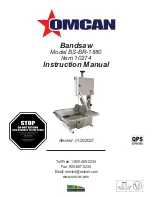
WARNING!
To avoid mistakes that could cause serious injury, do not plug in the chop
saw until you have read and understood the rules.
DANGER!
Potential hazard that will result in serious injury or loss of life.
WARNING!
Potential hazard that could result in serious injury or loss of life.
WARNING!
Read and understand all instructions. Failure to follow all instructions listed below may result in
electric shock, fire and/or serious personal injury.
CAUTION!
Potential hazard that may result in moderate injury or damage to equipment.
7
SAFETY GUIDELINES
6
SAFETY GUIDELINES
SAFETY GUIDELINES
This manual contains information that relates to PROTECTING PERSONAL SAFETY and PREVENTING
EQUIPMENT PROBLEMS. It is very important to read this manual carefully and understand it thoroughly before
using the product. The symbols listed below are used to indicate this information.
Note:
The word “
Note
” is used to inform the reader of something the operator needs to know about the tool.
SAFETY RECOMMENDATIONS
These precautions are intended for the personal safety of the operator and others working with the operator.
Failure to follow these instructions may result in a permanent loss of vision, serious personal or even fatal
injury, property damage and/or tool damage. Please take time to read and understand them.
Safety is a combination of common sense, staying alert, and knowing how your chop saw works.
GENERAL SAFETY RULES
WORK AREA
•
Keep your work area clean and well lit. Cluttered benches and dark areas invite accidents.
•
Do not operate power tools in potentially explosive environments, such as in the presence of flammable
liquids, gas or dust. Power tools create sparks that may ignite dust or fumes.
•
Keep bystanders, children and visitors away while operating the tool. Distractions can cause the operator
to lose control.
ELECTRICAL SAFETY
•
Power tool plugs must match the outlet. Never modify the plug in any way. Do not use any adaptor plugs
with earthed (grounded) power tools. Unmodified plugs and matching outlets will reduce risk of electric
shock.
•
Avoid contact between the operator’s body and grounded surfaces such as pipes, radiators, ranges and
refrigerators. There is an increased risk of electric shock if the operator’s body is grounded.
•
Do not expose power tools to rain or wet conditions. Water entering the power tool will increase the risk
of electric shock.
•
Do not abuse the cord. Do not use the power cord to carry the tool or to pull the plug out of the outlet.
Keep the power cord away from heat, oil, sharp edges, and moving parts. Replace a damaged power cord
immediately. A damaged power cord increases the risk of electric shock.
•
When operating a power tool outdoors, use an outdoor-rated extension cord type “W-A” or “W”. These
cords are rated for outdoor use and they reduce the risk of electric shock.
PERSONAL SAFETY
•
Stay alert, be aware of the surroundings, and use commen sense when operating a power tool. Do not
use a power tool while tired or under the influence of drugs, alcohol, or medication. A moment of
inattention while operating a power tool may result in serious personal injury.
•
Dress properly. Do not wear loose clothing or jewellery.
•
Contain long hair. Keep hair, clothing, and gloves away from moving parts. Loose clothing, jewellery, or
long hair can get caught in moving parts.
•
Avoid accidental start-ups. Verify that the switch is in the OFF position before plugging in the tool.
Carrying a power tool with a finger on the switch or plugging in a tool that has the switch in the ON
position invites accidents.
•
Remove adjusting keys and wrenches before turning the tool on. A wrench or key that is left attached to
a rotating part of the tool may result in personal injury.
•
Do not overreach. Keep proper footing and balance allows the operator to maintain better control of the
tool in unexpected situations.
•
Use safety equipment. Always wear eye protection.
•
Use a dust mask, non-skid safety shoes, a hardhat, or hearing protection when appropriate.
USE AND CARE OF POWER TOOLS
•
Use clamps or another practical means to secure and support the workpiece to a stable platform. Holding
the work in a hand or against the body is not stable, and may lead to loss of control.
•
Do not force the tool. Use the correct tool for the application. The correct tool will do the job better and
safer when used at the rate that it was designed to work at.
•
Do not use a power tool if it cannot be turned on or off using the power switch. A tool that cannot be
controlled using the switch is dangerous, and must be repaired.
•
Disconnect the plug from the outlet before making any adjustments, changing accessories, or storing the
tool. Such preventive safety measures reduce the risk of accidental start-ups.
•
When power tools are not in use, store them out of the reach of children or untrained persons. Tools are
dangerous in the hands of untrained users.
•
Maintain tools with care. Keep cutting tools sharp and clean. Properly maintained cutting tools with sharp
cutting edges are less likely to bind and are easier to control.
model no. 055-4500-6 | contact us 1-800-689-9928




































